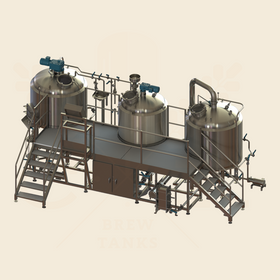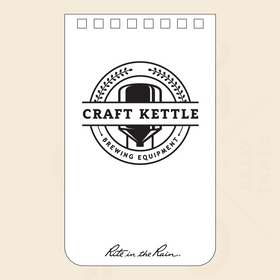
Pasteurization
For a certified beer snob, buying a 6-pack can be quite an ordeal: Approaching the cooler display, they are ready to work through a detailed routine, one with a high success rate for purchasing quality beer. First, they must consider beer style, which in turn opens a floodgate of questions: Is this a ‘solo’ drinking experience, or will others accompany them? What is the occasion? What is the current season or weather like? While the considerations pile up, so to do the styles deemed appropriate.
Next, with a general idea of allowable styles in mind, specific brands come in to play. Do they go with ‘old faithful’, the trusted 6-pack that never lets them down, or do they branch out to something entirely new? To help answer this they begin searching for a ‘packaged on’ or ‘best buy’ date, then weighing the results.
The beer snob’s internal monologue ensues: “This beer sounds neat, but no packaging date is provided.” They set the box down and move on to the next. “I know this is a great beer, but it’s 5 months old.” That too gets set down, believing there has to be a better option. “Wait a minute, what’s this?” They begin scanning through the contending package: It’s made by what the snob considers a quality-focused brewery, it fits in the ‘acceptable styles’, and it was packaged just two weeks ago. Bingo.
In reality, this is likely a condensed purchasing process for most beer snobs. Those with longer routines have learned not to shop with other people, as they are certain to annoy them with prolonged indecisiveness.
The beer snob described above certainly doesn’t portray every craft consumer. Most are likely fine with simply grabbing a brand they know, and not bothering to look at dates. Yet during this booming craft beer era, there is a growing movement of consumer awareness regarding product ‘freshness’ and overall quality. As brewers, not only should we encourage increased awareness toward product quality, but we should also be constantly seeking to improve our brands’ shelf stability.
Quality focused breweries are quite aware of the proper practices that need to be executed throughout cellaring and packaging to provide the longest possible shelf life for beer. Most of these practices revolve around the desire to decrease oxygen pickup as much as possible. Packaged oxygen causes many chemical compounds in beer to become oxidized, and the vast majority of these oxidized products have negative effects on the finished beer. After all, beer is an agricultural product; just like food, it has long been known that packaged oxygen rapidly deteriorates the contents inside.
Other than oxidative reactions, most entry level home brewers are familiar with another quality consideration. Even if you have brewed just one batch of beer, you likely noticed the extensive amount of cleaning and sanitizing required. Rest assured that most brewers (usually bearded, and wearing stained clothes) are not cleaning for the sake of cleaning, but are doing so to reduce the potential of microbial spoilage of wort and beer.
As brewers we usually want just one microorganism to succeed in enjoying our delicious wort or beer. And so we put so much effort into cleaning and sanitizing. ‘Brewing’ is often referred to as 90% cleaning and 10% actually making beer (though your mileage may vary). While experienced brewers have cleaning and sanitizing perfected as if they worked in an emergency room, tiny microbes still may find their way into the process. The potential risk this presents can result in a logistical headache involving product recalls, and also a financial nightmare regarding dumping of product.
To rule out this potential risk, and for other beneficial reasons, many breweries incorporate pasteurization into their cellaring or packaging process. As brewers, we again must tip our hats to French Scientist Louis Pasteur for his microbial discoveries that have dramatically benefited the industry. Pasteurization (can you guess where the name came from?) is the process of subjecting food or beverages to heat, in order to greatly reduce the number of living microorganisms present in the package.
For many foods and beverages (milk and juice in particular), pasteurization is applied to eliminate pathogens (disease causing microorganisms). Beer is different though, as it already provides an environment unwelcoming to pathogens: Low oxygen, high CO2, few nutrients (because yeast already utilized most), ethanol (a natural sanitizer), cold temperatures, and a low pH. Pasteurizing beer is therefore primarily for quality purposes.
Both flash pasteurizers and tunnel pasteurizers are common in the industry. Flash pasteurizers utilize a HTST (high temp short time) concept, while tunnel pasteurizers run more of a LTLT (low temp long time) concept. Flash pasteurizers take up considerably less floor space, and pasteurize beer ‘in line’, typically on the way to packaging. Tunnel pasteurizers on the other hand, pasteurize beer in the sealed package (cans or bottles). Keg volumes are too large to effectively tunnel pasteurize.
Time and temperature are both important factors in determining pasteurization effectiveness. The pasteurization unit (PU) is used to describe the rate at which a product is pasteurized. “For every minute the beer is held at 60°C (140°F) it is said to be subject to one pasteurization unit (PU). Holding for 15 min at 60°C, therefore, is 15 PUs of treatment.” (George Philliskirk, Beer and Brewing)
For temperatures above or below 140°F an equation like this can be used to estimate PUs:

PUs will vary by brand and brewery, though averages typically are around 15-25 PUs. As a rule of thumb, less dense beers (lower gravities) are typically subjected to fewer PUs and more dense beers (higher gravities) to higher PUs.

Photo: An example of a flash pasteurizer. Note the dark grey, square area; this depicts multiple heat exchangers. On its way into the system, beer is heated up with beer exiting the system. Likewise, beer exiting the system is cooled back down from beer entering the system. Glycol and steam heat exchangers are still applied, however, by utilizing energy recovery (heat and cold from the actual product), flash pasteurizers can be more than 90% efficient. Lastly, make note of the curved ‘back and forth’ piping on top of the system. This curved piping increases the overall length of piping, which provides the time necessary to hold the beer at a certain temperature, in order to obtain desired PUs.

Photo: An example of a tunnel pasteurizer. After cans or bottles are filled, they continue moving on a conveyor belt into the tunnel pasteurizer. They are then heated up with steam, which gets sprayed directly on to the sealed bottles. Multiple temperature raises are common, to allow a more gradual heating. Once desired PUs are obtained, the bottles or cans are then cooled back down by spraying with cold water.
Large macro breweries have long been pasteurizing their products to ensure shelf stability and maximize product distribution reach. Some craft breweries took to pasteurization early on, but by and large, pasteurization is still somewhat new to the craft brewing industry.
Some in the industry negatively view this heating up of finished beer. Even though the heating is quick (typically 15-30 seconds for flash pasteurization, and a few minutes for tunnel pasteurization) this high temperature increase undoubtedly has an effect on the flavor of the beer. Though to what degree is still largely unknown, and often debated.
Addressing pasteurization’s effect on draft beer taste, Micro Matic (a draft beer equipment supplier) suggests that it is likely a matter of personal taste, comparing it to peoples’ preferences to raw or cooked vegetables. Many brewers feel that pasteurization can actually round out the flavor of certain brands (often darker, denser beers), while lighter, less dense beers should be treated more delicately with lower PUs.
It is certainly understandable to question the necessity of pasteurization in brewing, and perhaps even view it negatively at first. The positive impacts are becoming more apparent though, and more brewers are beginning to understand the reasoning for implementing pasteurizers.
In addition to microbial destruction, brewers should continue looking at the other advantages pasteurization has on overall shelf stability. In a 2012 article in the Journal of Agriculture and Food Chemistry, scientists studied the impacts of pasteurization on lager beer and concluded the following:
“Pasteurization clearly improved the oxidative stability of beer determined by ESR (electron spin resonance) spectroscopy, whereas it had a minor negative effect on the volatile profile by increasing volatile compounds that is generally associated with heat treatment and a loss of fruity ester aroma.” (Andersen, et all, Effect of Pasteurization on the Protein Composition and Oxidative Stability of Beer during Storage).
Mentioned earlier, yeast that are still in solution are likely killed during pasteurization. This same journal entry notes that additional oxidative reactions, due likely to yeast protein metabolism, were also reduced in the pasteurized samples.
What this all translates to is a more predictable shelf life. Pasteurized beers are often said to be good for 120 days or more, depending on the brand and specifications. This provides the brewery an ease of mind, especially when expanding a distribution range.
But wait, there’s more! In a 2020 CBC (Craft Brewers Conference) online seminar, Caolan Vaughan at Stone and Wood Brewing (a large craft brewery in Australia) discussed the positive implications flash pasteurization had on the brewery’s problem with ‘hop creep’.
First, a quick definition on ‘hop creep’ for those unfamiliar: Hops naturally contain diastatic enzymes. When brewers ‘dry hop’ (add hops to a fermenting beer) they are adding these enzymes to the beer as well. This can be problematic, as these enzymes create fermentable sugars from existing dextrins (nonfermentable sugars) that the yeast are unable to digest. These enzymes work at cold temperatures and can cause any yeast present to continue fermenting these newly formed fermentable sugars. This unexpected fermenting causes gravity decreases, which can result in higher alcohol levels stated on the package, exploding or ‘gushing’ cans and bottles, and several other potentially negative quality side effects.
Caolan was skeptical about using pasteurization because of similar negative connotations mentioned above. After implementing a flash pasteurizer though, Stone and Wood found that they “Maintained flavor and aroma, achieved a microbiologically stabilized beer, and solved our problem (hop creep).” (Caolan Vaughan, CBC Online).
Caolan found that even pasteurizing the beer with 1 PU successfully denatured these enzymes, preventing ‘hop creep’, and also inhibited the growth of their house yeast strain. Stone and Wood continues to use this low pasteurization regiment: “Why pasteurize beer at a higher level when we know 1 PU is sufficient to denature hop enzymes?” (Caolan Vaughan, CBC Online).
Finally, the last pasteurization benefit to discuss involves preserving adjunct contribution or beer blends. Let look at adjunct contribution first. An adjunct is defined as any source of extract added to wort or beer that is not derived from malted barley.
Assume a brewer has finished fermenting a beer and for flavor or mouthfeel purposes, now wants to add fruit or ‘back sweeten’ (add sugar after fermentation). In order to safely package a commercial beer without pasteurization, the brewer must wait until all fermentable sugar added is fully fermented out by the yeast, which sometimes defeats the purpose of adding fruits/sugars. Or the brewer should absolutely ensure (via microbiological and analytical analysis) that no simple sugars remain, that the yeast is incapable of fermenting dextrins (some strains are), and that no other microorganisms are present.
Could you add watermelon to a beer, fully ferment the sugars out, serve it on draft in your taproom and be safe? Probably. Would you feel comfortable distributing that beer over a wide distribution range though? Maybe, but all it takes is one recall for you to rethink your processing steps for that brand.
So what about beer blending? For those unfamiliar, blending of multiple fermented batches is a commonly used technique among larger breweries. Blending allows these breweries to obtain extreme consistency from brand to brand. Perhaps beer in fermenter 1 has a higher rate of SO2 than normal. So what should you do? Easy… blend fermenter 1, at smaller percentages, with Fermenters 2, 3, and 4 when you transfer to the brite tank. (It’s likely not that ‘easy’, but you get the point).
The same concept applies to barrel or wood aged beer. Experienced brewers often describe blending as a challenging art separate from brewing. In a 2012 interview with Embrace the Funk (a website dedicated to sour beer), Lauren Limbach (Wood Cellar Director at New Belgium Brewing Company) discussed the use of a flash pasteurizer for New Belgium’s world renowned sour beer production. She stated that flash pasteurization “does have a side effect, but it’s a wonderful side effect. It locks the blend that I produce into place.”
Limbach continued: “You know some people store beers like Geuze for a really long time and what they don’t realize is that blender painstakingly made that blend. The blender tasted all their barrels and said ‘This percentage of this barrel, this percentage of this one, etc.’ That person brought all those together, tasted it and said ‘Perfect.’ But 3 years later, who knows what it’s like if it’s not pasteurized. So when you pasteurize you can definitely lock in the blend, but it can also oxidize.” (Lauren Limbach, Embrace the Funk)
When pasteurization is used in respect to these blends, the beer produced is more closely what the blender intended it to be. No yeast or other microbes will be able to alter the beer over time. Only oxygen can further change the beer, though we learned earlier that pasteurized beers have improved oxygen stability compared to non-pasteurized beers.
There is one more point to make regarding wood aged beers. Wood, by its nature, can never be sterile. In fact countless organisms inhabit wood; among them are wild yeasts and pellicle forming bacteria. If you’ve made kombucha before you are well aware of the pellicle that forms during fermentation as a results of bacteria and yeast metabolism. This same pellicle can form when wood aged beers are packaged. It is likely harmless to consume, but most customers don’t want floating, gooey globs of bacteria in their beer. Yet another positive appeal to pasteurization.

Photo: An example of a beer that formed a pellicle due microorganisms present in the bottle.
There was a lot to cover, but with pasteurization being somewhat controversial among brewers, it’s important to lay it all on the table. The debate over using pasteurization in brewing will likely continue, as it has with food and other beverages. While there is undoubtedly an effect on flavor (though to what degree is uncertain), the many quality benefits obtained likely balance this out. The quality focused beer snob mentioned at the beginning, should welcome proper pasteurization practices, though this consideration may prolong their beer buying process even more.
Happy brewing (and blending).
Photo References:
PU Equation:
https://www.redpostltd.com/support/science
Flash Pasteurizer:
centec.de/process-systems/brewery/flashpasto/
Tunnel Pasteurizer:
https://www.comacgroup.com/beverage-canning-machine/tunnel-pasteurizing-machine
Beer Bottle Pellicle:
https://homebrew.stackexchange.com/questions/10292/white-stuff-is-it-bad




